Drug Catalog - Product Detail
DULOXETINE HCL DR 30MG CP 1000
| NDC | Mfr | Size | Str | Form |
|---|---|---|---|---|
| 67877-0264-10 | ASCEND LABORATORIES | 1000 | 30MG | CAPSULE |
PACKAGE FILES
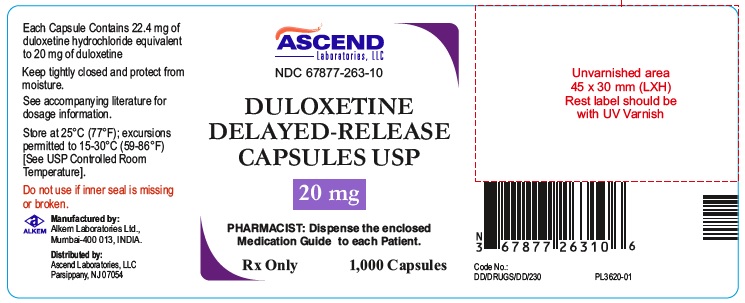
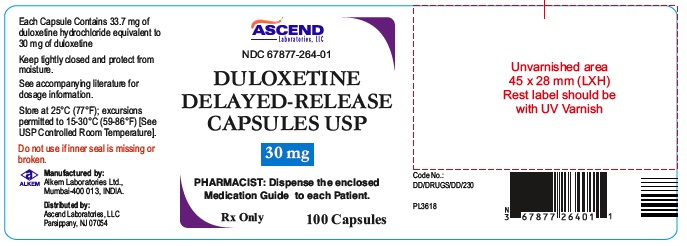
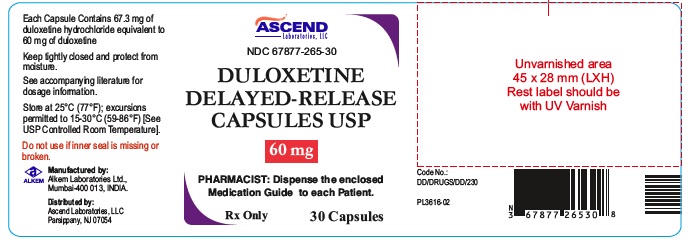


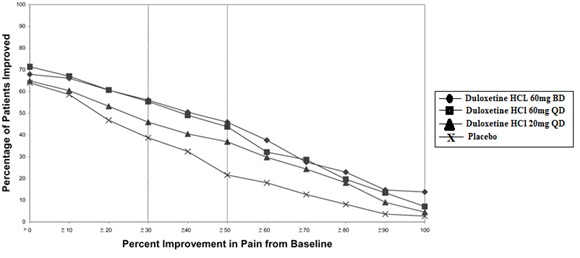

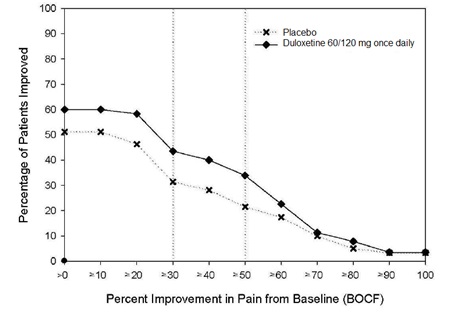

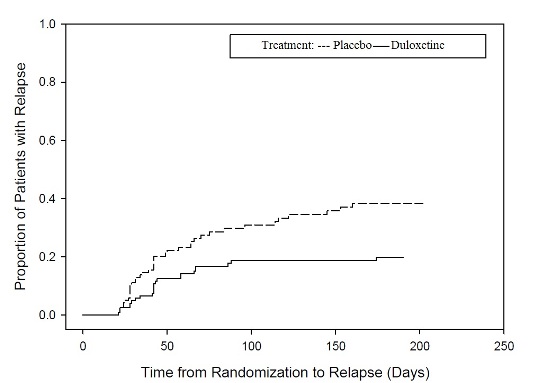
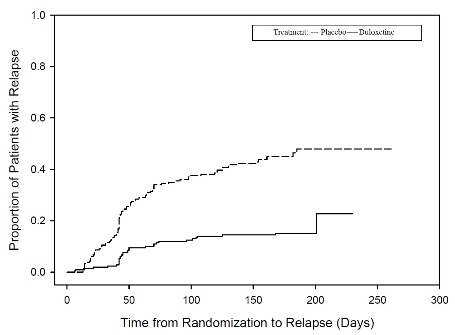
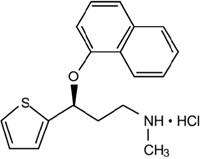
Generic Name
DULOXETINE
Substance Name
DULOXETINE HYDROCHLORIDE
Product Type
HUMAN PRESCRIPTION DRUG
Route
ORAL
Application Number
ANDA203197
Description
11 DESCRIPTION Duloxetine hydrochloride is a selective serotonin and norepinephrine reuptake inhibitor (SNRI) for oral administration. Its chemical designation is (+)-( S )- N -methyl-γ-(1-naphthyloxy)-2-thiophenepropylamine hydrochloride. The empirical formula is C 18 H 19 NOS•HCl, which corresponds to a molecular weight of 333.88. The structural formula is: Duloxetine hydrochloride is a white to off-white crystalline powder, which is slightly soluble in water. Each capsule contains enteric-coated pellets of 20, 30, or 60 mg of duloxetine (equivalent to 22.4, 33.7, or 67.3 mg of duloxetine hydrochloride, respectively). These enteric-coated pellets are designed to prevent degradation of the drug in the acidic environment of the stomach. Inactive ingredients include FD&C Blue No. 2, gelatin, hypromellose, hydroxypropyl cellulose, sodium lauryl sulfate, crosspovidone, sugar spheres, hypromellose phthalates, talc, titanium dioxide, and triethyl citrate. The 20 and 60 mg capsules also contain iron oxide yellow. The printing ink contains shellac, dehydrated alcohol, isopropyl alcohol, butyl alcohol, propylene glycol, strong ammonia solution, potassium hydroxide, black iron oxide (for 20 mg and 30 mg strengths), titanium dioxide and purified water. duloxetine-structure
How Supplied
16 HOW SUPPLIED/STORAGE AND HANDLING 16.1 How Supplied Duloxetine Delayed-Release Capsules USP are available as delayed release capsules in the following strengths, colors, imprints, and presentations: Features Strengths 20 mg a 30 mg a 60 mg a Body color Opaque green White Green Cap color Opaque green Blue Blue Cap imprint Dulox Dulox Dulox Body imprint 20mg 30mg 60mg Capsule size 3 2 0 Presentations and NDC Codes Bottles of 30 67877-263-30 67877-264-30 67877-265-30 Bottles of 60 67877-263-60 Bottles of 90 67877-263-90 67877-264-90 67877-265-90 Bottles of 100 67877-263-01 67877-264-01 67877-265-01 Bottles of 1000 67877-263-10 67877-264-10 67877-265-10 a equivalent to duloxetine base 16.2 Storage and Handling Store at 25°C (77°F); excursions permitted to 15-30°C (59-86°F) [ see USP Controlled Room Temperature].
Indications & Usage
1 INDICATIONS AND USAGE Duloxetine is indicated for the treatment of: Major depressive disorder in adults Generalized anxiety disorder in adults and pediatric patients 7 years of age and older Diabetic peripheral neuropathic pain in adults Fibromyalgia in adults and pediatric patients 13 years of age and older Chronic musculoskeletal pain in adults Duloxetine hydrochloride is a serotonin and norepinephrine reuptake inhibitor (SNRI) indicated for the treatment of the following conditions: Major depressive disorder (MDD) in adults ( 1 ) Generalized anxiety disorder (GAD) in adults and pediatric patients 7 years of age and older ( 1 ) Diabetic peripheral neuropathic pain (DPNP) in adults ( 1 ) Fibromyalgia (FM) in adults and pediatric patients 13 years of age and older ( 1 ) Chronic musculoskeletal pain in adults ( 1 )
Dosage and Administration
2 DOSAGE AND ADMINISTRATION Take duloxetine delayed-release capsules once daily, with or without food. Swallow whole; do not crush, chew, or open capsule ( 2.1 ) Indication Starting Dose Target Dose Maximum Dose MDD (2.2) 40 mg/day to 60 mg/day Acute Treatment: 40 mg/day (20 mg twice daily) to 60 mg/day (once daily or as 30 mg twice daily); Maintenance Treatment: 60 mg/day 120 mg/day GAD (2.3) Adults Geriatric Pediatrics (7 to 17 years of age) 60 mg/day 30 mg/day 30 mg/day 60 mg/day (once daily) 60 mg/day (once daily) 30 to 60 mg/day (once daily) 120 mg/day 120 mg/day 120 mg/day DPNP (2.4) 60 mg/day 60 mg/day (once daily) 60 mg/day FM (2.5) Adults and Pediatrics (13 to 17 years of age) 30 mg/day 60 mg/day (once daily) 60 mg/day Chronic Musculoskeletal Pain (2.6) 30 mg/day 60 mg/day (once daily) 60 mg/day Discontinuing duloxetine delayed-release capsules: Gradually reduce dosage to avoid discontinuation symptoms ( 2.8 , 5.7 ) 2.1 Important Administration Instructions Administer duloxetine delayed-release capsules orally (with or without meals) and swallow whole. Do not chew or crush, and do not open the delayed-release capsule and sprinkle its contents on food or mix with liquids because these actions might affect the enteric coating. If a dose of duloxetine delayed-release capsules is missed, take the missed dose as soon as it is remembered. If it is almost time for the next dose, skip the missed dose and take the next dose at the regular time. Do not take two doses of duloxetine delayed-release capsules at the same time. 2.2 Dosage for Treatment of Major Depressive Disorder in Adults The recommended starting dosage in adults with MDD is 40 mg/day (given as 20 mg twice daily) to 60 mg/day (given either once daily or as 30 mg twice daily).For some patients, it may be desirable to start at 30 mg once daily for 1 week, to allow patients to adjust to duloxetine before increasing to 60 mg once daily. While a 120 mg/day dose was shown to be effective, there is no evidence that doses greater than 60 mg/day confer any additional benefits. Periodically reassess to determine the need for maintenance treatment and the appropriate dosage for such treatment. 2.3 Dosage for Treatment of Generalized Anxiety Disorder Recommended Dosage in Adults Less than 65 Years of Age For most adults less than 65 years of age with GAD, initiate duloxetine capsules 60 mg once daily. For some patients, it may be desirable to start at 30 mg once daily for 1 week, to allow patients to adjust to duloxetine capsules before increasing to 60 mg once daily. While a 120 mg once daily dosage was shown to be effective, there is no evidence that doses greater than 60 mg/day confer additional benefit. Nevertheless, if a decision is made to increase the dosage beyond 60 mg once daily, increase dosage in increments of 30 mg once daily. Periodically reassess to determine the continued need for maintenance treatment and the appropriate dosage for such treatment. Recommended Dosage in Geriatric Patients In geriatric patients with GAD, initiate duloxetine capsules at a dosage of 30 mg once daily for 2 weeks before considering an increase to the target dose of 60 mg/day. Thereafter, patients may benefit from doses above 60 mg once daily. If a decision is made to increase the dose beyond 60 mg once daily, increase dose in increments of 30 mg once daily. The maximum dose studied was 120 mg per day. Recommended Dosage in Pediatric Patients 7 to 17 Years of Age Initiate duloxetine in pediatric patients 7 to 17 years of age with GAD at a dosage of 30 mg once daily for 2 weeks before considering an increase to 60 mg once daily. The recommended dosage range is 30 to 60 mg once daily. Some patients may benefit from dosages above 60 mg once daily. If a decision is made to increase the dose beyond 60 mg once daily, increase dosage in increments of 30 mg once daily. The maximum dose studied was 120 mg per day. 2.4 Dosage for Treatment of Diabetic Peripheral Neuropathic Pain in Adults Administer 60 mg once daily in adults with diabetic peripheral neuropathic pain. There is no evidence that doses higher than 60 mg once daily confer additional significant benefit and the higher dosage is clearly less well tolerated. For patients for whom tolerability is a concern, a lower starting dose may be considered. Since diabetes is frequently complicated by renal disease, consider a lower starting dosage and gradual increase in dosage for patients with renal impairment [see Dosage and Administration ( 2.7 ) and Use in Specific Populations ( 8.10 )]. 2.5 Dosage for Treatment of Fibromyalgia Recommended Dosage in Adults The recommended duloxetine delayed-release capsules dosage is 60 mg once daily in adults with fibromyalgia. Begin treatment at 30 mg once daily for 1 week, to allow patients to adjust to duloxetine delayed-release capsules before increasing to 60 mg once daily. Some patients may respond to the starting dosage. There is no evidence that dosages greater than 60 mg/day confer additional benefit, even in patients who do not respond to a 60 mg/day dosage, and higher dosages were associated with a higher rate of adverse reactions. Recommended Dosage in Pediatric Patients 13 to 17 Years of Age The recommended starting duloxetine delayed-release capsules dosage in pediatric patients 13-17 years of age with fibromyalgia is 30 mg once daily. The dosage may be increased to 60 mg once daily based on response and tolerability. 2.6 Dosage for Treatment of Chronic Musculoskeletal Pain in Adults The recommended duloxetine delayed-release capsules dosage is 60 mg once daily in adults with chronic musculoskeletal pain. Begin treatment at 30 mg once daily for one week, to allow patients to adjust to duloxetine delayed-release capsules before increasing to 60 mg once daily. There is no evidence that higher dosages confer additional benefit, even in patients who do not respond to a 60 mg once daily dosage, and higher dosages are associated with a higher rate of adverse reactions [see Clinical Studies ( 14.6 )] . 2.7 Dosage in Patients with Hepatic Impairment or Severe Renal Impairment Avoid use in patients with chronic liver disease or cirrhosis [see Warnings and Precautions ( 5.14 ) and Use in Specific Populations ( 8.9 )] . Avoid use in patients with severe renal impairment, GFR <30 mL/minute [see Warnings and Precautions (5.14) and Use in Specific Populations ( 8.10 )] . 2.8 Discontinuing Duloxetine Adverse reactions after discontinuation of duloxetine, after abrupt or tapered discontinuation, include: dizziness, headache, nausea, diarrhea, paresthesia, irritability, vomiting, insomnia, anxiety, hyperhidrosis, and fatigue. A gradual reduction in dosage rather than abrupt cessation is recommended whenever possible [see Warnings and Precautions (5.7) ] . 2.9 Switching a Patient to or from a Monoamine Oxidase Inhibitor (MAOI) Intended to Treat Psychiatric Disorders At least 14 days should elapse between discontinuation of an MAOI intended to treat psychiatric disorders and initiation of therapy with duloxetine. Conversely, at least 5 days should be allowed after stopping duloxetine before starting an MAOI intended to treat psychiatric disorders [see Contraindications (4) ] . 2.10 Use of Duloxetine with Other MAOIs such as Linezolid or Methylene Blue Do not start duloxetine in a patient who is being treated with linezolid or intravenous methylene blue because there is an increased risk of serotonin syndrome. In a patient who requires more urgent treatment of a psychiatric condition, other interventions, including hospitalization, should be considered [see Contraindications (4)] . In some cases, a patient already receiving duloxetine therapy may require urgent treatment with linezolid or intravenous methylene blue. If acceptable alternatives to linezolid or intravenous methylene blue treatment are not available and the potential benefits of linezolid or intravenous methylene blue treatment are judged to outweigh the risks of serotonin syndrome in a particular patient, duloxetine should be stopped promptly, and linezolid or intravenous methylene blue can be administered. The patient should be monitored for symptoms of serotonin syndrome for 5 days or until 24 hours after the last dose of linezolid or intravenous methylene blue, whichever comes first. Therapy with duloxetine may be resumed 24 hours after the last dose of linezolid or intravenous methylene blue [see Warnings and Precautions (5.4) ] . The risk of administering methylene blue by non-intravenous routes (such as oral tablets or by local injection) or in intravenous doses much lower than 1 mg/kg with duloxetine is unclear. The clinician should, nevertheless, be aware of the possibility of emergent symptoms of serotonin syndrome with such use [see Warnings and Precautions (5.4) ] .
